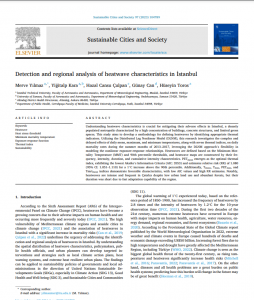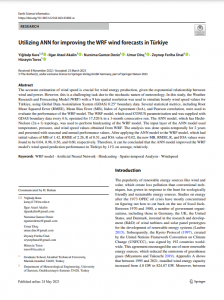Aday Öğrenci
Canlı Destek
Fakültemiz Meteoroloji Mühendisliği Araştırma Görevlilerinden Yiğitalp Kara’nın yayınlamış olduğu 2 adet SCI yayınla ilgili bilgiler aşağıdadır. Kendisini tebrik ediyoruz.
Utilizing ANN for improving the WRF wind forecasts in Türkiye
Kara, Y., Akalin, I.A., Deniz, N.G. et al. Utilizing ANN for improving the WRF wind forecasts in Türkiye. Earth Sci Inform (2023). https://doi.org/10.1007/s12145-023-01003-w
The accurate estimation of wind speed is crucial for wind energy production, given the exponential relationship betweenwind and power. However, this is a challenging task due to the stochastic nature of meteorology. In this study, the WeatherResearch and Forecasting Model (WRF) with a 9 km spatial resolution was used to simulate hourly wind speed values forTürkiye, using Global Data Assimilation System (GDAS) 0.25° boundary data. Several statistical metrics, including RootMean Squared Error (RMSE), Mean Bias Error (MB), Index of Agreement (IoA), and Pearson correlation, were used toevaluate the performance of the WRF model. The WRF model, which used CONUS parametrization and was supplied withGDAS boundary data every 6 h, operated for 17,520 h in a 1-month consecutive run. The ANN model, which has Hecht-Nielsen (2n + 1) topology, was used to perform hindcasting of the WRF model. The input layer of the ANN model usedtemperature, pressure, and wind speed values obtained from WRF. The analysis was done spatio-temporally for 2 yearsand presented with seasonal and annual performance values. After applying the ANN model to the WRF model, which hadinitial values of MB of 1.42, RMSE of 2.26, R of 0.51, and IOA value of 0.02, the new MB, RMSE, R, and IOA values werefound to be 0.04, 0.96, 0.56, and 0.60, respectively. Therefore, it can be concluded that the ANN model improved the WRFmodel’s wind speed prediction performance in Türkiye by 11% on average, relatively.
Özet olarak çalışmanın kapsamı: Bu çalışma, makine öğrenmesi metodlarından biri olan ANN modelini, sayısal hava tahmin modellerinden biri olan WRF çerçevesine dahil ederek Türkiye’deki rüzgar hızı tahminlerinin doğruluğunu önemli ölçüde artırdığını ve bu durumun rüzgar enerjisi üretimini optimize etmek için hayati önem taşıdığını göstermiştir. Ortalama olarak, ANN modeli Türkiye’deki WRF modelinin rüzgar hızı tahmin performansını %11 oranında artırmıştır.
Detection and regional analysis of heatwave characteristics in İstanbul
Yılmaz, M., Kara, Y., Çulpan, H. C., Can, G., & Toros, H. (2023). Detection and regional analysis of heatwave characteristics in İstanbul. Sustainable Cities and Society, 97, 104789. https://doi.org/https://doi.org/10.1016/j.scs.2023.104789
Understanding heatwave characteristics is crucial for mitigating their adverse effects in İstanbul, a densely populated metropolis characterized by a high concentration of buildings, concrete structures, and limited green spaces. This study aims to develop a methodology for defining heatwaves by identifying appropriate thermal indicators. Utilizing the Distributed Lag Nonlinear Model (DLNM), this research investigates the complex and delayed effects of daily mean, maximum, and minimum temperatures, along with seven thermal indices, on daily mortality rates during the summer months of 2013–2017, leveraging the DLNM approach’s flexibility in modeling the nonlinear exposure-response relationships. Heatwaves are defined based on the Minimum Mortality Temperature (MMT) and 90th percentile thresholds, and heatwave maps are constructed by their frequency, intensity, duration, and cumulative intensity characteristics. PETmean emerges as the optimal thermal index, exhibiting the lowest Akaike’s Information Criteria (AIC: 3553) and estimates relative risk (RR) of 1.080 (95% CI: 1.051–1.110) for a 1°C increase above the 90th percentile. Additionally, Tmean, Tmax, PETmax, and Tmrtmean indices demonstrate favorable characteristics, with low AIC values and high RR estimates. Notably, heatwaves are intense and frequent in Çatalca despite low urban land use and abundant forests, but their duration was short due to fast adaptation capability of the region.
Özet olarak çalışmanın kapsamı: Bu çalışma, İstanbul’un yoğun nüfuslu bir metropol olması, yüksek yapı yoğunluğu, beton yapılar ve sınırlı yeşil alanlara sahip olması nedeniyle, sıcak dalgaların olumsuz etkilerini anlamak için sıcak dalgaların özelliklerini tanımlamanın önemli olduğunu belirtmektedir. Çalışmada, Sıcak hava dalgaları, Minimum Ölüm Sıcaklığı (MMT) ve %90’lık eşik değerlere dayanılarak tanımlanmış ve sıcak dalgaların frekansı, yoğunluğu, süresi ve birikimli yoğunluğu özelliklerine İstanbul nezdinde haritalandırılmıştır. Ayrıca, Tortalama, Tmaksimum, PETmaksimum ve Tmrtortalama indeksleri düşük AIC değerlerine ve yüksek RR tahminlerine sahip olmasıyla sıcak hava dalgası tespiti için istenilen karakteristik özellikler göstermiştir.

